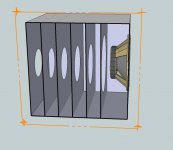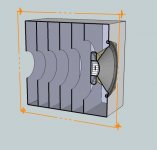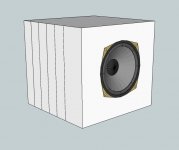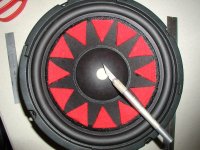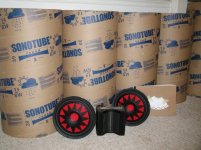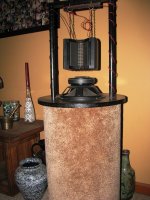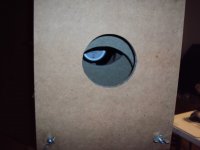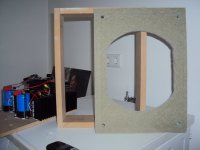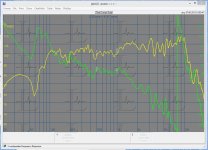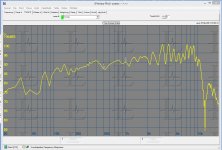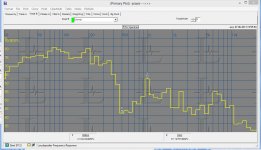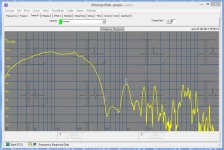I was thinking of gun silencers and wondered if the same idea could be used for speakers to reduce the rear sound. Probably a silly idea but would like to get your thoughts and ideas.
Attachments
Hi speakermagic! I love to see people think "out of the box" and come up with new concepts and ideas.
Are you aware of aperiodic speaker enclosure designs? There is a lot of good things to study there. I must confess that I am a bit biased tho because I use an aperiodic design in my speakers.... which are (gasp) omni directional. So - I am really familiar with people throwing things like rotten veggies at me.... 😀😀😀
aperiodic loudspeaker enclosure design - Google Search
Are you aware of aperiodic speaker enclosure designs? There is a lot of good things to study there. I must confess that I am a bit biased tho because I use an aperiodic design in my speakers.... which are (gasp) omni directional. So - I am really familiar with people throwing things like rotten veggies at me.... 😀😀😀
aperiodic loudspeaker enclosure design - Google Search
Attachments
Actually a cabinet like that exists. It is the Hartley Boffle.
ACTIVE LOUDSPEAKER SYSTEM: Subwoofer, Construction, Cabinets, Electronic Filter/Tube Crossover, Amplifiers, Units.
ACTIVE LOUDSPEAKER SYSTEM: Subwoofer, Construction, Cabinets, Electronic Filter/Tube Crossover, Amplifiers, Units.
There are a variety of lining materials that are effective at mitigating the back wave.
Doesn't need to be aperiodic to do the job.
Doesn't need to be aperiodic to do the job.
Neat idea. I think what you have drawn may actually act more like a series of resonant Helmholtz resonators rather than a gun silencer (which acts more like a muffler for high velocity gases by reducing the differential in the gun's escaping gases by storing the expansion and releasing them sequentially, thereby reducing the sudden gas expansion that accompanies a gun shot's gases. Note that a bullet traveling at supersonic speeds still makes its own sonic boom - so silencers are truly only effective for special sub-sonic cartridges used in movies. In real life - not effective at all with conventioal supersonic ammo.
Anyhow, the tapered spiral (semi-infinite tube) like the B&W Nautilus also aims to achieve this.
Anyhow, the tapered spiral (semi-infinite tube) like the B&W Nautilus also aims to achieve this.
Yes, silencers are effective with super-sonic ammunition. A silencer for, say a .308 sniper rifle is similar in size & shape to an automotive "glasspack" muffler ( One can easily build one with said muffler).
A rifle sound is composed of two elements, the muzzle blast and the "report" of the projectile breaking the sound barrier. The muzzle blast is far louder & can be muffled, the "crack" sound is the projectile. Fortunately the crack sound eminates along the flight path making it difficult to localize, the muzzle blast can be localized.....both are heard well after the projectile finds its mark.
-----------------------------------------------------------Rick..........
A rifle sound is composed of two elements, the muzzle blast and the "report" of the projectile breaking the sound barrier. The muzzle blast is far louder & can be muffled, the "crack" sound is the projectile. Fortunately the crack sound eminates along the flight path making it difficult to localize, the muzzle blast can be localized.....both are heard well after the projectile finds its mark.
-----------------------------------------------------------Rick..........
Thanks again
Hi Joachim,
Thanks for the link to Hartley.
I love the simplicity of the early audio pioneer's R&D, very focused on sound quality and common sense as well as a solid grounding in the physics and maths.
Today there is such a huge choice of low cost computer / software and sophisticated measurement equipment that some folks get lost in the world of measuring .... Because they can!
They get fixated on a particular technical aspect they can measure to the N'th degree and this eventually leads to the point where their oscilliscope & screens become more important than their ears...
Thanks again for this and all your very valuable contributions, I know I have learned a lot from your good self!
Cheers
Derek.
Hi Joachim,
Thanks for the link to Hartley.
I love the simplicity of the early audio pioneer's R&D, very focused on sound quality and common sense as well as a solid grounding in the physics and maths.
Today there is such a huge choice of low cost computer / software and sophisticated measurement equipment that some folks get lost in the world of measuring .... Because they can!
They get fixated on a particular technical aspect they can measure to the N'th degree and this eventually leads to the point where their oscilliscope & screens become more important than their ears...
Thanks again for this and all your very valuable contributions, I know I have learned a lot from your good self!
Cheers
Derek.
it looks to me quite like a possible implementation of a Labyrinth enclosure. Certainly would be worth trying with a closed box suitable driver. s
So far i did only measurements. What i found is that the hole diameters and alignment of the segments is very uncritical.
Looking forward to pics and measurements. It might be interesting to have differently-offset holes in the panels as a means to control midrange leakage.
IG
IG
Here are pictures of my prototype.
A fried had build me the frames. The green stuff is a soft fiber board.
The box is held together with tapped steel rods and big screws so i can change the fiberboards. I experimented with different diameter holes and arrangements ( big to small,
small to big, mixed ) but that did not make a big difference. The box is undamped otherwise.
I will publish some measurements soon.
A fried had build me the frames. The green stuff is a soft fiber board.
The box is held together with tapped steel rods and big screws so i can change the fiberboards. I experimented with different diameter holes and arrangements ( big to small,
small to big, mixed ) but that did not make a big difference. The box is undamped otherwise.
I will publish some measurements soon.
Attachments
Here are maesurements.
Nearfield, farfield, round exit pink noise, round exit sine sweep.
I modified the BG20. I cut away the wizzer and coated the membrane.
Response is qiute extended and linear, a bit rising.
That can be taken care of by the crossover.
The impedance curve looks a bit like a reflex box but with very low mechanical losses.
You see that in the steep impedance peaks. I think this is the main advantage of this kind of enclosure. The speaker is controled by the amplifier and not so much by the box.
i would say this is the oposite of a transmission line that goes down deep but also has energy storage and loss. The boffle will draw much less current from the amp for the same output. Maybe the transmission line goes deeper but it will likely be much bigger in size.
Nearfield, farfield, round exit pink noise, round exit sine sweep.
I modified the BG20. I cut away the wizzer and coated the membrane.
Response is qiute extended and linear, a bit rising.
That can be taken care of by the crossover.
The impedance curve looks a bit like a reflex box but with very low mechanical losses.
You see that in the steep impedance peaks. I think this is the main advantage of this kind of enclosure. The speaker is controled by the amplifier and not so much by the box.
i would say this is the oposite of a transmission line that goes down deep but also has energy storage and loss. The boffle will draw much less current from the amp for the same output. Maybe the transmission line goes deeper but it will likely be much bigger in size.
Attachments
The offset holed-baffles were exactly what I was thinking. 🙂 Cool modular build!
I gotta say, the impedance curve is very similar to that of a 12" Karlson. Fb=60Hz, with a valley at ~155Hz (Fb2) and a smaller peak at ~200Hz. In the case of the Karlson, these are the rear and front chamber tunings. What could it be here?
IG
I gotta say, the impedance curve is very similar to that of a 12" Karlson. Fb=60Hz, with a valley at ~155Hz (Fb2) and a smaller peak at ~200Hz. In the case of the Karlson, these are the rear and front chamber tunings. What could it be here?
IG
Well, that is the total impedance of the enclosed air.
That can be linearised by some damping material but that will also lower the peaks in the bass.
That can be linearised by some damping material but that will also lower the peaks in the bass.
- Status
- Not open for further replies.
- Home
- Loudspeakers
- Full Range
- Silencer Speaker Baffle
